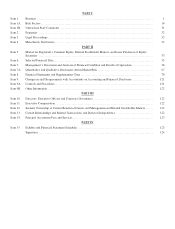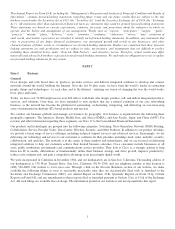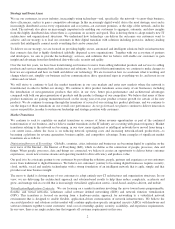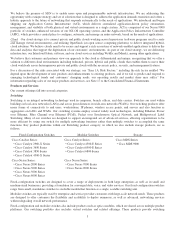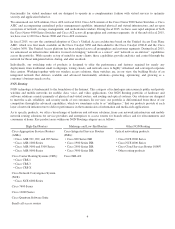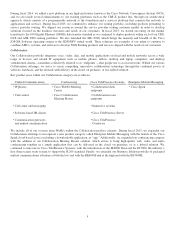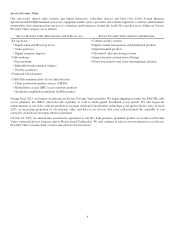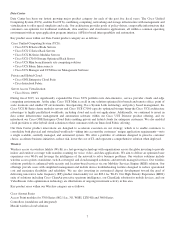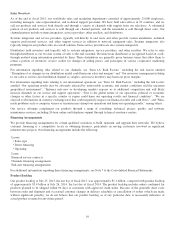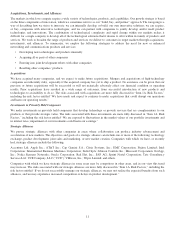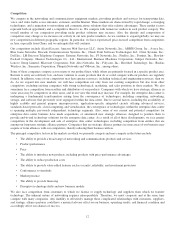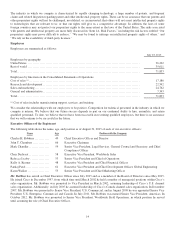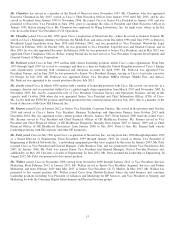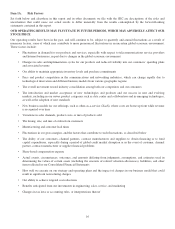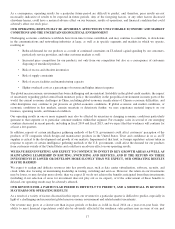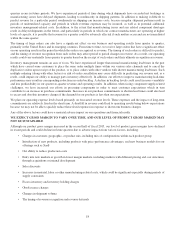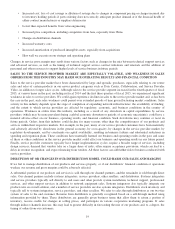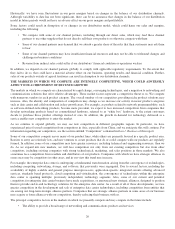Cisco 2015 Annual Report Download - page 18
Download and view the complete annual report
Please find page 18 of the 2015 Cisco annual report below. You can navigate through the pages in the report by either clicking on the pages listed below, or by using the keyword search tool below to find specific information within the annual report.Sales Overview
As of the end of fiscal 2015, our worldwide sales and marketing departments consisted of approximately 25,000 employees,
including managers, sales representatives, and technical support personnel. We have field sales offices in 93 countries, and we
sell our products and services both directly and through a variety of channels with support from our salesforce. A substantial
portion of our products and services is sold through our channel partners, and the remainder is sold through direct sales. Our
channel partners include systems integrators, service providers, other resellers, and distributors.
Systems integrators and service providers typically sell directly to end users and often provide system installation, technical
support, professional services, and other support services in addition to network equipment sales. Systems integrators also
typically integrate our products into an overall solution. Some service providers are also systems integrators.
Distributors hold inventory and typically sell to systems integrators, service providers, and other resellers. We refer to sales
through distributors as our two-tier system of sales to the end customer. Revenue from distributors is recognized based on a sell-
through method using information provided by them. These distributors are generally given business terms that allow them to
return a portion of inventory, receive credits for changes in selling prices, and participate in various cooperative marketing
programs.
For information regarding risks related to our channels, see “Item 1A. Risk Factors,” including the risk factors entitled
“Disruption of or changes in our distribution model could harm our sales and margins” and “Our inventory management relating
to our sales to our two-tier distribution channel is complex, and excess inventory may harm our gross margins.”
For information regarding risks relating to our international operations, see “Item 1A. Risk Factors,” including the risk factors
entitled “Our operating results may be adversely affected by unfavorable economic and market conditions and the uncertain
geopolitical environment”; “Entrance into new or developing markets exposes us to additional competition and will likely
increase demands on our service and support operations”; “Due to the global nature of our operations, political or economic
changes or other factors in a specific country or region could harm our operating results and financial condition”; “We are
exposed to fluctuations in currency exchange rates that could negatively impact our financial results and cash flows”; and “Man-
made problems such as computer viruses or terrorism may disrupt our operations and harm our operating results,” among others.
Our service offerings complement our products through a range of consulting, technical, project, quality, and software
maintenance services, including 24-hour online and telephone support through technical assistance centers.
Financing Arrangements
We provide financing arrangements for certain qualified customers to build, maintain, and upgrade their networks. We believe
customer financing is a competitive factor in obtaining business, particularly in serving customers involved in significant
infrastructure projects. Our financing arrangements include the following:
Leases:
• Sales-type
• Direct financing
• Operating
Loans
Financed service contracts
Channels financing arrangements
End-user financing arrangements
For additional information regarding these financing arrangements, see Note 7 to the Consolidated Financial Statements.
Product Backlog
Our product backlog at July 25, 2015, the last day of fiscal 2015, was approximately $5.1 billion, compared with product backlog
of approximately $5.4 billion at July 26, 2014, the last day of fiscal 2014. The product backlog includes orders confirmed for
products planned to be shipped within 90 days to customers with approved credit status. Because of the generally short cycle
between order and shipment and occasional customer changes in delivery schedules or cancellation of orders (which are made
without significant penalty), we do not believe that our product backlog, as of any particular date, is necessarily indicative of
actual product revenue for any future period.
10


